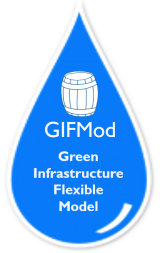Green Infrastructure Modeling Toolkit
Toolkit to help decision makers implement stormwater management practices
EPA has developed innovative models, tools, and technologies for communities to manage water runoff in urban and other environments. The resources in this toolkit incorporate green or a combination of green and gray infrastructure practices to help communities manage their water resources in a more sustainable way, increasing resilience to future changes.
Storm Water Management Model (SWMM)
SWMM is a software application that is used widely throughout the world for large-scale planning, analysis, and design related to stormwater runoff, combined and sanitary sewers, and other drainage systems in urban areas—although there are many applications for drainage systems in non-urban areas as well. It allows users to represent combinations of green infrastructure practices to determine their effectiveness in managing runoff. SWMM was developed to help support local, state, and national stormwater management objectives to reduce runoff through infiltration and retention.
National Stormwater Calculator (SWC)
The SWC is a software application that estimates the annual amount of stormwater runoff from a specific location in the United States (including Puerto Rico), based on local soil conditions, land cover, and historic rainfall records. It is used to inform site developers on how well they can meet a desired stormwater retention target with and without the use of green infrastructure. The SWC is available as a Windows-based desktop program and as a mobile web application that can be used on desktop devices and on mobile devices, such as smartphones and tablets, and is compatible with all operating systems. Both versions require an internet connection. A cost estimation module and a future climate scenario module are included. The SWC is a resource for all Rainwater Management Credits in LEED by the U.S. Green Building Council for all project types in all rating systems.
Green Infrastructure Wizard (GIWiz)
GIWiz is an interactive web application that provides users with customized reports containing EPA tools and resources with direct links and overview information.
Watershed Management Optimization Support Tool (WMOST)
WMOST is a software application designed to facilitate integrated water resources management across wet and dry climate regions. It allows water resources managers and planners to screen a wide range of practices across their watershed or jurisdiction for cost-effectiveness and environmental and economic sustainability. WMOST allows users to select up to fifteen stormwater management practices, including traditional grey infrastructure, green infrastructure, and other low impact development practices.
Visualizing Ecosystems for Land Management Assessment (VELMA) Model
VELMA is a computer software model that regional planners and land managers can use to quantify the effectiveness of natural and engineered green infrastructure management practices for reducing nonpoint sources of nutrients and contaminants in streams, estuaries, and groundwater. These practices include riparian buffers, cover crops, and constructed wetlands.
Green Infrastructure Flexible Model (GIFMod)
GIFMod is a computer program that can be used to evaluate the performance of urban stormwater and agricultural green infrastructure practices. It allows users to build conceptual models of green infrastructure practices to predict hydraulic and water quality performance under given weather scenarios. GIFMod also allows for interpreting the field and lab data collected by the researchers via its deterministic and probabilistic inverse modeling capabilities. Modeling of green infrastructure performance in GIFMod can be done in three levels, including hydraulics, particle transport, and constituent fate and transport. (Note: Not included in video at top of page.)






